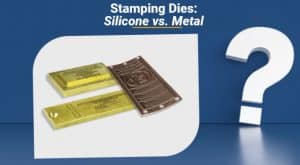Silicone Hot Stamp Dies and Metal Hot Stamp Dies: A Comparison
An Overview
What are the differences between silicone hot stamp dies and metal hot stamp dies?
There are important similarities and differences between silicone hot stamp dies and metal hot stamp dies. To better understand which is best-suited to your decoration project it is helpful to start with a basic definition.
What is a stamping die?

Hot stamp dies carry graphics which are transferred via pressure to the surface of a product or component. Hot stamping dies can be made of silicone or metal. The choice of which type of stamping die to use will be dictated by requirements of your specific decoration project.
What types of hot stamp dies are there?
Stamping dies are frequently made of silicone (various formulations available) or metal (steel, brass or magnesium options available). Each option comes with its own set of benefits and considerations.
What formats of silicone and metal hot stamp dies are available?
Silicone hot stamp dies are available in single or dual durometer formats. Metal hot stamp dies can be made of steel, brass or magnesium. Both silicone hot stamp dies and metal hot stamp dies can be flat or contoured. Additionally, silicone dies can be crowned or multi-level. Both silicone and metal hot stamp dies are avaiable in traditional or magnetic mounting formats with complete die finishing services.
Silicone or Metal: What type of hot stamp die do I need?
This is a question that can be answered with a short answer, a medium answer or a long answer. Let’s start here with a short answer.
The Short Answer: What type of hot stamp die do I need?
When selecting a die material, a good simple rule to use the following guideline:
Rigid substrate →Flexible, silicone die
Flexible substrate→ Rigid, metal die
This simple rule-of-thumb will guide you to the right general category of die. From there, a trusted die expert can help you identify the precise type of silicone or metal die that is best suited to the unique requirements of your project.
Medium Answer: What type of hot stamp die do I need?
A slightly longer answer to this question requires a look at the similarities and differences between silicone and metal hot stamp dies. Both silicone and metal dies provide high impact decoration with metalic, holographic or prismatic foils.
There are some key differences as well however:
Silcone Dies
- More cost-effective than steel or brass
- Less pressure required
- Better conformity to slight surface variations
- No plastic deformation around artwork area
Metal Dies
- Embossed visual effect
- Higher stamping speeds
- Longer life
- May cause plastic deformation
Long Answer: What type of hot stamp die do I need?
Do you need an even more detailed answer? If so, please check out this table. Here you will find detailed comparitive information about silicone rubber and metal stamping dies. This information includes – available materials, average die life, sinks, set up time, pressure and temperature requirements, decorative finishes, price guidelines and compatible substrates for both silicone rubber and metal stamping dies.
| Rubber Dies | Metal Dies | |
| Materials Available | Various for specific applications – high temperatures, quick heat recovery, & high strength | Magnesium Copper Brass Steel |
| Average Die Life | Contoured – X Flat – 2X |
Magnesium – Y Copper – 4Y Brass – 18Y Steel – 20Y+ |
| Surface Variations (sinks) | Will Compensate | No Compensation for Sinks |
| Variation in Material Thickness | Will Compensate | No Compensation |
| Set-up Time | Quick Process | Lengthy Process |
| Pressure Requirements | 350 lbs. Per sq. inch (HS) 500 lbs. Per sq. inch (HT) |
1000 lbs. Per sq. inch |
| Temperature Requirements | 100F > Metal (approximately 300-400F) |
100F < Rubber (approximately 250-300F) |
| Dwell Time | 50% > Metal | 30% < Rubber |
| Decorative Finish | Foil/Transfer lays on top of substrate | Imbeds foil/transfer into surface |
| Price | Initial Set-up/Mold Charge Die Cost < Metal |
No Set-up/Mold Charge Magnesium – $ Copper – 2X $ Brass – 8X $ Steel – 10X $ |
| Substrates *indicates preferred material |
ABS Acetal Acrylic Polyamide (Nylon) Polycarbonate Polyethylene Polystyrene PVC – Plasticized PVC – Rigid* SAN* UV Coating Epoxy / Epoxy Coating Polyurethane Wood |
ABS Acetal* Acrylic Leather* Paper* Polyamide (Nylon)* Polycarbonate* Polyethylene* Polystyrene PVC – Plasticized PVC – Rigid SAN UV Coating* Epoxy / Epoxy Coating Polyurethane |
What are key features to look for in a die manufacturer?
In addition to being able to provide you with expert advice on the type of silicone or metal die best-suited to your unique application, United Silicone can provide:
Magnetic Quick-Change Dies
Time saving magnetic quick change dies can lead to up to 90x faster changeover speeds with up to 50% improvement in mounting accuracy
Precision Molds
Top die manufacturers should provide CNC machine engraved molds with crown or contoured surfaces to perfectly match part shapes/configurations.
Expert Tools – Eliminate Voids
Expertise on using texturing tool and raised dies to eliminate voids.
Large Capacity for Quick Die Turn Around
For example, United Silicone´s market-leading die capacity allows us to provide 1 to 3 day service on many die orders.
Would you like to know more?
Please get in touch. We would love to hear from you.